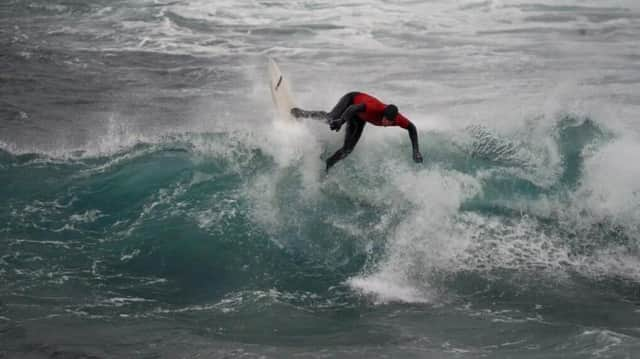Celebrating 50 years of the Scottish National Surfing Championships


Conditions permitting, competitive surfing in Scotland will celebrate its 50th anniversary from 7-9 April, when the Scottish National Surfing Championships take place in Thurso. Whether the heats are run in the long, winding walls of Thurso East or the faster, hollower waves at nearby Brims Ness, it promises to be an intriguing year, with a new generation of surfers spearheaded by recent first-time winners Craig McLachlan and Phoebe Strachan now challenging the more established names.
Scotland’s first ever national surf contest was held in 1973, just along the coast from Thurso at Bettyhill (at this early stage in the history of Scottish surfing, the full potential of the reefs around Thurso had yet to be properly recognised). Bill Batten of Edinburgh Surf Club, one of the original surf pioneers from the south-east of Scotland, took the win, and he won again in 1974 and 1976, with Andy Bennetts, also of Edinburgh Surf Club, taking the title in 1975. Ian McKay from Edinburgh then managed to win five titles between 1979 and 1987.
Advertisement
Hide AdAdvertisement
Hide AdThis early dominance by south-east surfers wasn’t to last, however, and since then the majority of winners have hailed either from the north or north-east. Malcolm Findlay of Fraserburgh won in 1977 and ’78, before picking up two more titles in the 80s and a fifth in 1995, in a remarkably lengthy career, while the late Ian Masson of Broch Surf Club won a total of seven titles between 1990 and 1998.
In the years after the millennium, the title was largely traded between two surfers: Mark Cameron of Broch Surf Club, who has won a total of seven titles, and Chris Noble of North Shore Surf Club, with six. Latterly, Scottish team captain Mark Boyd has been the man to beat, winning in 2018, 2019 and 2022. The women’s division didn’t begin until later, and in recent years Thurso’s Shoana Blackadder has dominated.
There are, of course, plenty of people within the surfing community who don’t see the point of surf contests. Surely, they argue, an activity that’s all about communing with Mother Nature doesn’t require timed heats, trophies and somebody with a megaphone on the beach shouting out scores after every wave. And anyway, how can you possibly decide whether one surfer’s ride is "better" than another’s?
Fortunately, however, the ocean is a big place, so those who don’t like surfing competitively don’t have to take part – they don’t even have to spectate. Even if the international surfing circus turns up at your local surf spot (as it did in Thurso every year from 2006 to 2011, when it hosted high-profile World Qualifying Series events) you’re still free to go and surf around the next headland for a few days until things get back to normal. And as for scoring systems, well... the World Surf League’s judging criteria are actually pretty clear. Nobody objects to competitive gymnastics because the judges have to assess aesthetics as well as physical accomplishment, so why should surfing be any different?
It’s not as if competitive surfing is a new concept either, imposed by a results-obsessed modern society on what was once a carefree, prelapsarian pastime: there’s plenty of evidence that the Hawaiians were into competing long before Captain Cook "discovered" Hawaii in 1778. They took it pretty seriously, too. In his paper "Surfing in Hawaii", published in The Journal of the Polynesian Society in 1959, Ben R. Finney gives the following account:
"A contest in which a great chief of Hawaii, Umi-a-liloa, took part tells us something of the seriousness of a surfing contest... Umi, before gaining his office as high chief, attended a surfing match at Laupahoehoe, Hawaii. While there he was challenged by Paiea, a lesser chief, to a surfing match with only a small bet, which Umi refused because of the insignificant amount of the wager. When Paiea offered to bet four double canoes, Umi accepted the match, defeated his opponent, and won the canoes. However, during the match Paiea’s surfboard struck Umi on the shoulder and scratched off some of his skin. At that time Umi said nothing, but upon coming to power as a high chief he had Paiea killed and taken to the heiau at Waipunalei to be sacrificed to Umi’s god." All of which puts even the fiercest rivalries of the professional surfing era into some kind of perspective.
That said, however, what is the history of surfing if not a string of era-defining competitive rivalries? What would the Eighties have been without the great head-to-head battles between California’s Tom Curren and Australia’s Mark Occhilupo? And what were the Noughties if not one long, intense battle of wills between Florida’s Kelly Slater and Hawaii’s Andy Irons? Say what you like about competition killing the soul of surfing, but it has also given us some of the sport’s most sublime moments, and top athletes pushing each other to the limit in good surf will always be spectacular to watch. For proof, head to Thurso next weekend.
See www.thessf.com
